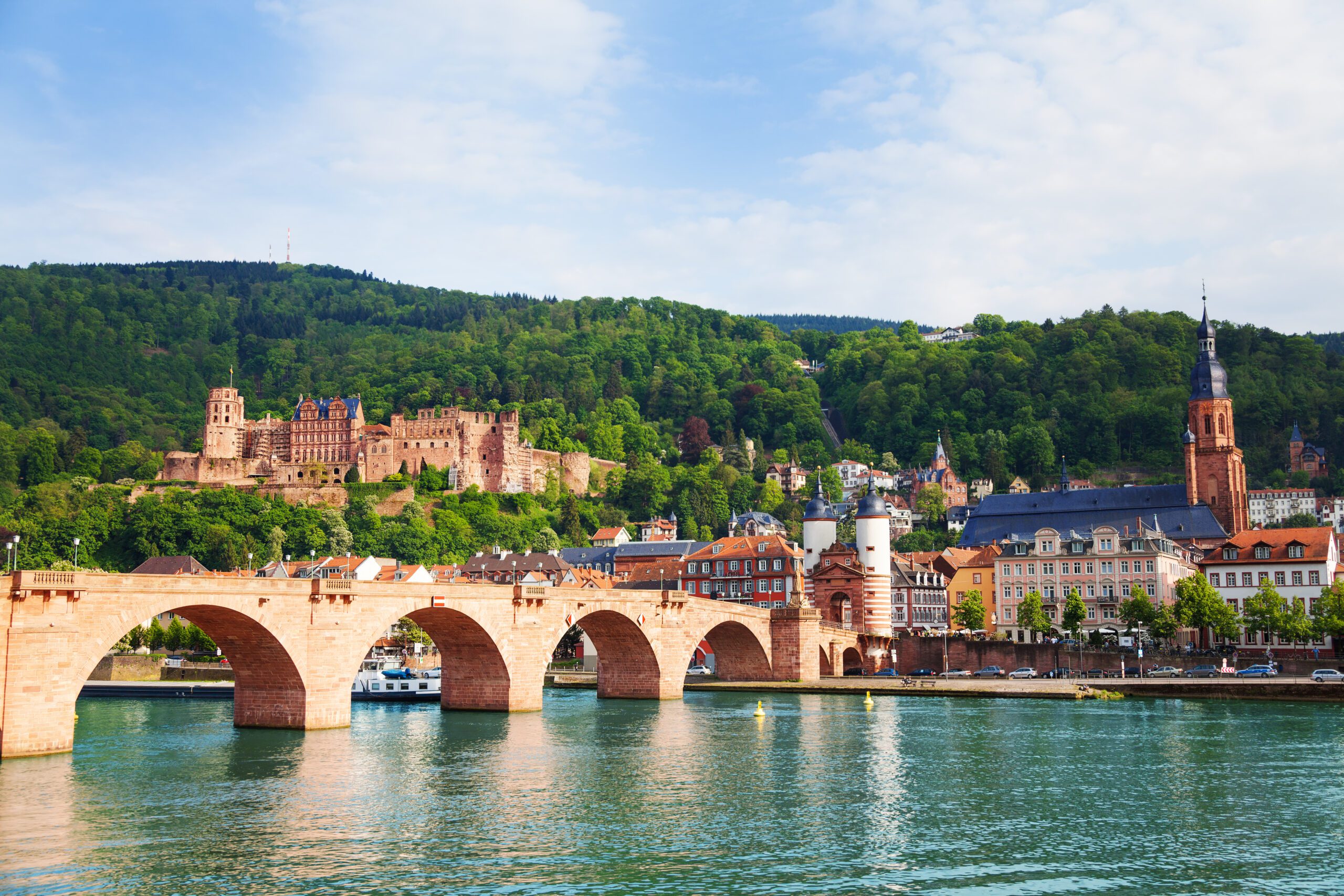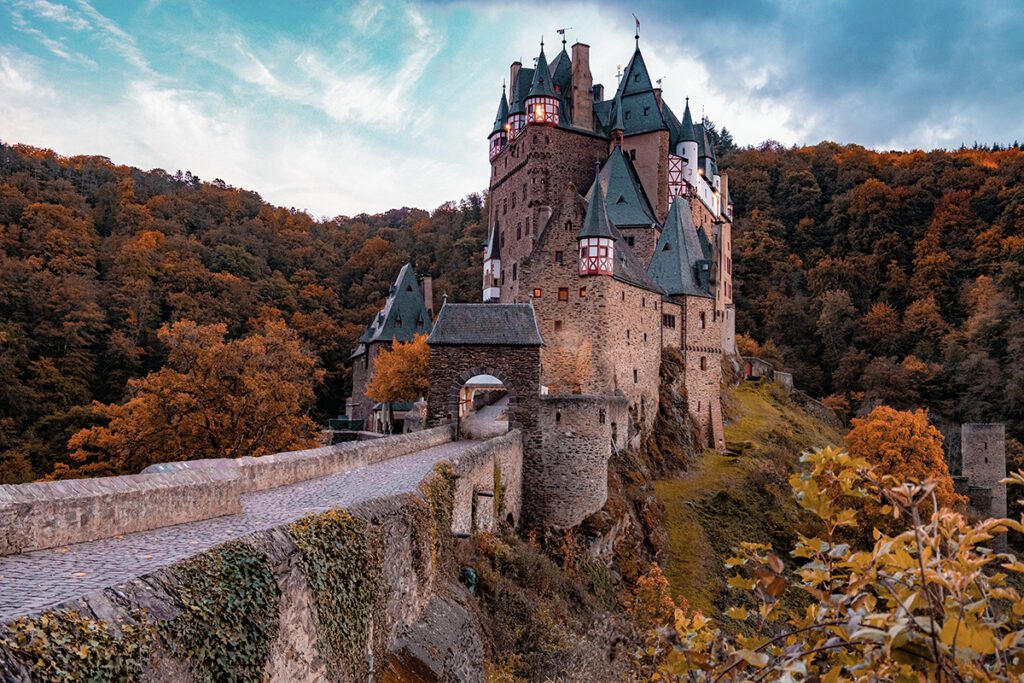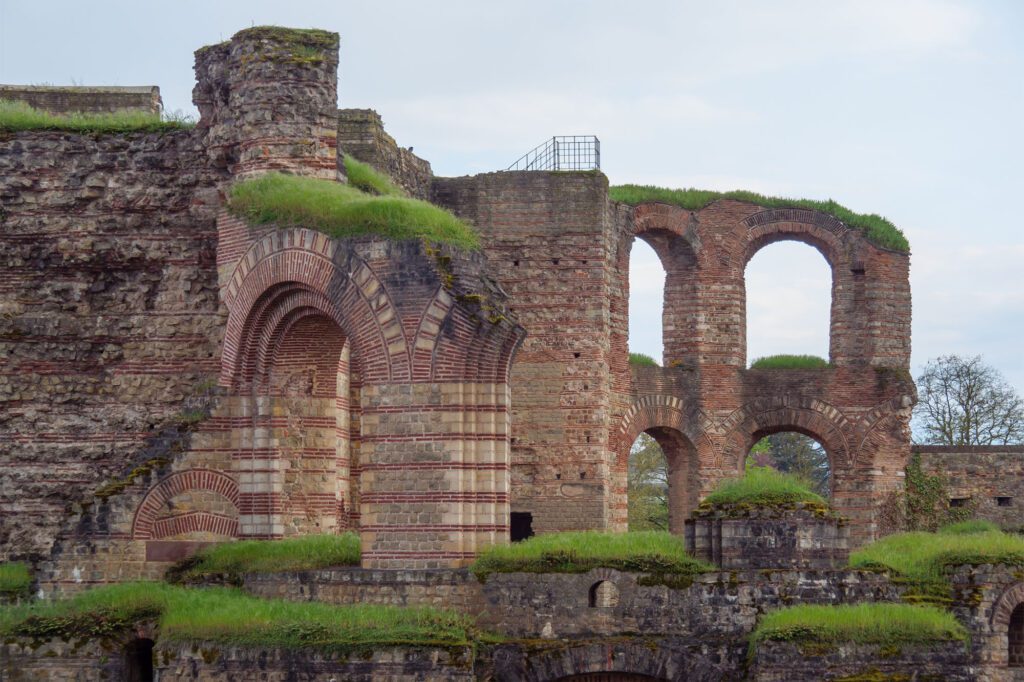With this 14-day Germany itinerary, you’ll dive deep into the country’s history and cultural heritage. Starting your trip in Frankfurt and ending it in Berlin, you’ll travel to the historic Jewish sites in the SHUM cities of Mainz and Worms and the pivotal settings of the Reformation at Wartburg Castle and in Wittenberg.
Along the way, you’ll visit the old cities of Heidelberg and Trier and sip world-renowned Rieslings amidst vineyards along the Moselle rivers. And let’s not forget the postcard-perfect vistas of the castles along the Rhine which you can spot from a leisurely cruise on the Rhine river.
Tip: Click on the markers in the interactive map to get additional information and see pictures of each stop along the way.
Arrival in Frankfurt
Day 1
Upon landing in Frankfurt, you have the choice of unwinding from your trip in a hotel for a night, or making your way to Mainz, which will your home base for the next three days.
Mainz
Day 2
Explore the multifaceted city of Mainz for a day steeped in history and culture. Mainz has long been a significant Catholic stronghold, dating back to the Early Middle Ages. The city is home to the remarkable St. Martin’s Cathedral, erected in 975, which stands as a testament to its religious importance.
However, it’s St. Stephen’s Church that often captures visitors’ attention, thanks to its unique blue stained-glass windows designed by artist Marc Chagall. The light filtering through these windows creates a serene atmosphere, accentuating the Biblical figures depicted. Interestingly, Chagall, who was Jewish, was persuaded by a priest in 1978 to undertake this project as a symbol of friendship between Jews and Christians.
For those interested in Jewish history, Mainz has much to offer. The city is part of the SHUM cities, along with Speyer and Worms, which were collectively granted World Heritage Status in 2021. The Old Jewish Cemetery and the New Synagogue are significant sites that shouldn’t be missed. Please note that visits to the New Synagogue require prior reservation.
Yet, Mainz is not just about religious history. The city is also the birthplace of Johannes Gutenberg, the inventor of the printing press. A visit to the Gutenberg Museum provides valuable insights into how this invention shaped modern media. The museum even houses an original Gutenberg Bible, printed in 1454.
Conclude your day by taking a leisurely stroll through Mainz’s old town with its patrician townhouses, narrow lanes, and cobblestone streets.
Worms
Day 3
Worms holds a significant chapter in the annals of the Protestant Reformation. It was here that the Edict of Worms was issued in 1521, leading to the excommunication of Martin Luther. As you stroll through Luther Square, you’ll encounter the world’s largest Reformation monument. It showcases Luther, clutching a Bible, surrounded by key figures who paved the way for the Reformation. While the original buildings that hosted Luther have not survived—falling victim to the Nine Years’ War in 1689—the city is still rich in sites that echo its storied past.
For those wishing to further explore Jewish cultural sites, a visit to the Cemetery Heiliger Sand, Europe’s oldest Jewish cemetery, and the old synagogue complex is in order.
Heidelberg
Day 4

On today’s itinerary: Heidelberg. Your exploration of the city starts in the old town, home to the iconic stone bridge built between 1786 and 1788. This structure replaced earlier wooden versions that succumbed to the ravages of war and floods.
High on top of the old town sits Heidelberg Castle,which was the seat of the Palatine Counts and Electors from the House of Wittelsbach, who governed the region for over four centuries. Start your visit with a leisurely stroll through the palace gardens, followed by a guided tour of the opulent interiors.
While at the castle, make sure to visit the German Apothecary Museum. This museum offers a fascinating look at fully preserved apothecary interiors dating from the 17th to the 19th centuries—a truly unique experience.
To round off your day, hop on the funicular to ascend to the King’s Seat, or Königsstuhl in German. The viewing platform there offers panoramic vistas of the valley, providing a moment of reflection to cap off your enriching day.
Rhine River Cruise
Day 5
After immersing yourself in urban exploration for two days, today offers a change of pace—a leisurely boat tour on the Rhine River.
The Upper Middle Rhine Valley, often referred to as the Romantic Rhine, is a UNESCO World Heritage Site and an absolute haven for castle enthusiasts. Along a 65-mile stretch between the cities of Bingen and Koblenz, you’ll encounter 40 castles, most of them situated on hilltops, and framed by terraced vineyards and culturally rich small towns. See Castles on the River Rhine for a lowdown on the castles you can expect to see.

Post-tour, make your way to Rüdesheim, a town celebrated for its wine making heritage. The Drosselgasse is a charming cobblestone street leading, where you’ll find a delightful array of authentic wine taverns (or should I say “wine gardens”?) Here, you can savor regional wines accompanied by traditional German fare and live music.
Bernkastel-Kues
Day 6
For the next leg of your journey, you’ll transition to the scenic Moselle River Valley. This river elegantly winds its way through a captivating landscape, dotted with quaint, charming towns. The Moselle region is globally celebrated for its exceptional white Riesling wines. Here, you’ll have ample opportunities to indulge in local flavors, whether it’s in cozy taverns, directly at vineyards, or through educational winery tours.
Your base for the next three nights will be Bernkastel-Kues, a town that boasts an array of stunning half-timbered houses. After exploring the town, you’ll find that wine tasting is conveniently at your fingertips. Numerous wineries surround Bernkastel-Kues, with the Vinothek standing out as the largest. Housed in a historic vaulted cellar, the Vinothek offers an impressive selection of 150 regional Riesling wines.
Elz Castle
Day 7

Today, you’re set to explore Eltz Castle, a striking fortress perched atop a mountain, framed by lush forests. What sets Eltz Castle apart from other Rhine Valley landmarks is its remarkable resilience; it has stood undamaged for over 850 years. Even more intriguing is that it has remained in the possession of the Eltz family throughout its entire history. For those seeking a genuine medieval experience, this is your destination. Your guided tour will take you through the castle’s intimate living spaces, from the bedrooms to the knights’ hall, and even the armory. You’ll also get a glimpse of the castle’s rich collection, featuring gold and silver works, porcelain, firearms, and armor.
Travelers seeking a physical activity, may opt to go on a bike ride. The Moselle River Path is one of the prettiest river bike paths in Germany. It connects France & Luxembourg to the east with Koblenz in the west. But don’t worry: you won’t have to bicycle the entire 150 miles to get the experience. The path has convenient “hop off, hop on” points allowing you to bicycle convenient segments that are between 10-20 miles long.
Trier
Day 8
Today, you’ll set your course for Trier, Germany’s oldest city and another UNESCO World Heritage Site on your journey. Trier was once known as “The Second Rome,” and offers an array of archaeological sites, e.g. the Porta Negra and the Roman bath, which provide valuable insights into its rich history. The city’s compact layout is an added advantage, allowing you to explore its key attractions within a matter of hours.
By the way, Trier boasts a notable native son: Karl Marx, born here in 1818. His birthplace, situated in the city center, has been transformed into a museum dedicated to Marx. The museum offers an in-depth look at Marx’s life, the evolution of his philosophical and economic theories, and their enduring impact on the trajectory of history, up to the present day.

Wartburg Castle
Day 9
Today, you’ll bid farewell to the Moselle Valley and set your sights on Wartburg Castle in Eisenach. This castle is not just a UNESCO World Heritage Site but also a landmark of historical significance that transcends Germany’s borders. In this very castle, Martin Luther, the monk, translated the New Testament into German in 1521, forever changing the spiritual landscape of Europe. If you’ve visited the Gutenberg Museum in Mainz earlier in your trip, you may have already glimpsed Luther’s Bible. The absolute highlight of the castle is the Luther Room, which also marks the birthplace of written German—a language that was essentially formalized by Luther himself.
But there’s more to explore within this expansive castle complex. You’ll find a grand hall and a music hall, and if the timing is on your side, you might even catch a classical concert, as they are regularly scheduled here. Fun Fact: Wartburg Castle is situated almost exactly at the geographical center of Germany.
Eisenach-Wittenberg
Day 10
Before you proceed to Wittenberg, your next destination, consider delving into the life of another eminent figure from Eisenach: Composer Johann Sebastian Bach was born here in 1685. The museum dedicated to him offers an engaging narrative of his life and his music through interactive installations. And you’ll even be able to catch a live concert set against the backdrop of the museum’s historical rooms.
Approximately two hours from Wartburg, you’ll arrive in Wittenberg, colloquially known as “Lutherstadt.” The Lutherhouse, where Martin Luther once resided as a monk and later with his family, now serves as the world’s most extensive museum dedicated to Reformation history. The exhibits provide a compelling look into Luther’s life and the transformative impact of his work.
Berlin and Departure
Day 11,12,13, 14
Your German journey reaches its grand finale in Berlin, a city that offers something for every traveler’s taste. With three full days at your disposal, you’ll have the chance to explore iconic landmarks like the TV Tower and Brandenburg Gate. Don’t miss Museum Island, another UNESCO World Heritage Site, which houses an impressive array of first-rate art and history museums. If your interests veer towards the events of the 20th century, then the Berlin Wall Memorial and East Side Gallery are essential stops on your itinerary.
But Berlin’s allure extends beyond its historical sites and museums. As Germany’s capital, it’s a magnet for global creatives and the epicenter of the country’s burgeoning startup scene. This fusion creates a dynamic, inventive atmosphere that you’ll experience firsthand in the city’s artisan shops, cafes, and eateries. To truly soak in Berlin’s eclectic culture, I recommend dedicating some time meandering through its diverse neighborhoods.

![Castles on the Romantic Rhine River [with map]](https://germanytravelcompany.com/wp-content/uploads/2023/10/pfalzgrafensteinsmallsize.jpeg)